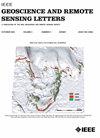BP积分后二维波数域运动目标重聚焦算法
IF 4
3区 地球科学
Q2 ENGINEERING, ELECTRICAL & ELECTRONIC
引用次数: 12
摘要
用频域算法对运动目标进行聚焦时,方位角频谱不完全包含在脉冲重复频带内,由于将能量分散到伪影上,可能导致检测性能下降。为了避免这一问题,提出了一种反投影积分后的重聚焦算法。其主要思想是先对运动目标进行均匀粗聚焦进行检测,然后提取检测到的目标进行再聚焦。通过推导波数谱的精确解析表达式,直接在小尺寸提取数据的二维波数域上进行运动参数估计和运动补偿,只需进行快速傅立叶变换和快速傅立叶反变换,无需插值,从而降低了计算复杂度。最后得到运动目标的重聚焦图像。机载和星载合成孔径雷达数据的调焦结果验证了该方法的有效性。本文章由计算机程序翻译,如有差异,请以英文原文为准。
Moving Target Refocusing Algorithm in 2-D Wavenumber Domain After BP Integral
Focusing moving targets with frequency-domain algorithms may suffer from azimuth spectrum not entirely contained within a pulse-repetition frequency band, which may lead to degraded detection performance due to distributing the energy to the artifacts. In order to avoid this problem, a refocusing algorithm after back-projection integral is proposed. The main idea is first to uniformly and coarsely focus moving targets for detection, and then extract the detected targets for refocusing. By deriving the exact analytic expression of the wavenumber spectrum, motion parameter estimation and motion compensation are directly carried out on the 2-D wavenumber domain of the small-sized extracted data, which involves fast Fourier transform and Inverse Fast Fourier Transform operations only with no interpolation, thus reduces the computational complexity. Then, the final refocused image of the moving target is achieved. Refocusing results of both airborne and spaceborne synthetic aperture radar data are shown to validate the effectiveness of the proposed method.
求助全文
通过发布文献求助,成功后即可免费获取论文全文。
去求助
来源期刊

IEEE Geoscience and Remote Sensing Letters
工程技术-地球化学与地球物理
CiteScore
7.60
自引率
12.50%
发文量
1113
审稿时长
3.4 months
期刊介绍:
IEEE Geoscience and Remote Sensing Letters (GRSL) is a monthly publication for short papers (maximum length 5 pages) addressing new ideas and formative concepts in remote sensing as well as important new and timely results and concepts. Papers should relate to the theory, concepts and techniques of science and engineering as applied to sensing the earth, oceans, atmosphere, and space, and the processing, interpretation, and dissemination of this information. The technical content of papers must be both new and significant. Experimental data must be complete and include sufficient description of experimental apparatus, methods, and relevant experimental conditions. GRSL encourages the incorporation of "extended objects" or "multimedia" such as animations to enhance the shorter papers.
 求助内容:
求助内容: 应助结果提醒方式:
应助结果提醒方式:


